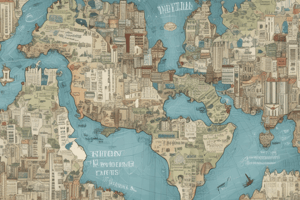Podcast
Questions and Answers
What is the primary purpose of institutions in the context of international management?
What is the primary purpose of institutions in the context of international management?
- To provide stability and meaning to social life (correct)
- To eliminate all forms of economic uncertainty
- To facilitate foreign direct investment only
- To promote globalization and international trade
Which of the following best describes foreign direct investment (FDI)?
Which of the following best describes foreign direct investment (FDI)?
- Investment that occurs when a firm invests directly in production and maintains control (correct)
- A method of investing through international financial markets
- Investment in financial assets such as stocks and bonds
- The exchange of goods and services across borders without direct ownership
Which of the following is NOT considered a component of formal institutions?
Which of the following is NOT considered a component of formal institutions?
- Regulations
- Laws
- Rules
- Norms (correct)
What type of economic system is characterized by government control over resource allocation?
What type of economic system is characterized by government control over resource allocation?
Which of the following pillars supports informal institutions?
Which of the following pillars supports informal institutions?
What is the primary focus of the 'thin' view of institutions?
What is the primary focus of the 'thin' view of institutions?
How do institutions influence multinational enterprises (MNEs) according to the 'thin' view?
How do institutions influence multinational enterprises (MNEs) according to the 'thin' view?
What does isomorphism in organizational behavior refer to?
What does isomorphism in organizational behavior refer to?
What is a key characteristic of the 'thick' view of institutions?
What is a key characteristic of the 'thick' view of institutions?
What do institutions provide to economic agents according to the 'thick' view?
What do institutions provide to economic agents according to the 'thick' view?
What influences organizational structure and practices the most due to institutional pressures?
What influences organizational structure and practices the most due to institutional pressures?
Which statement best describes the role of institutions in shaping managerial decisions?
Which statement best describes the role of institutions in shaping managerial decisions?
What does culture ensure within a social group?
What does culture ensure within a social group?
Which of the following concepts is closely correlated with culture?
Which of the following concepts is closely correlated with culture?
In Hofstede's framework, what does high power distance indicate?
In Hofstede's framework, what does high power distance indicate?
What is a characteristic of organizations in high power distance cultures?
What is a characteristic of organizations in high power distance cultures?
What role does language play in perpetuating culture?
What role does language play in perpetuating culture?
Which dimension was NOT one of the original dimensions in Hofstede's study?
Which dimension was NOT one of the original dimensions in Hofstede's study?
How are the behaviors and traditions of religious adherents influenced?
How are the behaviors and traditions of religious adherents influenced?
What does a high power distance culture typically value?
What does a high power distance culture typically value?
What is a result of cultural learning through language and imitation?
What is a result of cultural learning through language and imitation?
What is a key characteristic of firms in Liberal Market Economies (LMEs)?
What is a key characteristic of firms in Liberal Market Economies (LMEs)?
Which type of innovation is more commonly followed by firms in Coordinated Market Economies (CMEs)?
Which type of innovation is more commonly followed by firms in Coordinated Market Economies (CMEs)?
Which of the following is true regarding the sector focus of firms in LMEs compared to CMEs?
Which of the following is true regarding the sector focus of firms in LMEs compared to CMEs?
What type of relation is emphasized by firms in LMEs?
What type of relation is emphasized by firms in LMEs?
Which process do firms in CMEs utilize to resolve coordination problems?
Which process do firms in CMEs utilize to resolve coordination problems?
What does comparative institutional advantage lead to in LMEs?
What does comparative institutional advantage lead to in LMEs?
What is a significant finding regarding the classification of liberal and coordinated economies?
What is a significant finding regarding the classification of liberal and coordinated economies?
How do firms in CMEs typically behave compared to those in LMEs?
How do firms in CMEs typically behave compared to those in LMEs?
What is a typical outcome of the institutional frameworks in LMEs?
What is a typical outcome of the institutional frameworks in LMEs?
Flashcards
Globalization
Globalization
The interconnectedness of the global economy, marked by increased international trade, foreign direct investment, and financial market integration.
International Trade
International Trade
The exchange of goods and services across national borders. It involves exporting and importing.
Foreign Direct Investment (FDI)
Foreign Direct Investment (FDI)
Investment made by a company in a foreign country to establish a presence and maintain control over operations.
Institutions
Institutions
Signup and view all the flashcards
Legal Systems
Legal Systems
Signup and view all the flashcards
Ethics
Ethics
Signup and view all the flashcards
Thin View of Institutions
Thin View of Institutions
Signup and view all the flashcards
Thick View of Institutions
Thick View of Institutions
Signup and view all the flashcards
Isomorphism
Isomorphism
Signup and view all the flashcards
Institutional Distance
Institutional Distance
Signup and view all the flashcards
Institutional Context
Institutional Context
Signup and view all the flashcards
Rules of the Game
Rules of the Game
Signup and view all the flashcards
Culture
Culture
Signup and view all the flashcards
Power Distance
Power Distance
Signup and view all the flashcards
Uncertainty Avoidance
Uncertainty Avoidance
Signup and view all the flashcards
Individualism vs. Collectivism
Individualism vs. Collectivism
Signup and view all the flashcards
Language
Language
Signup and view all the flashcards
Masculinity vs. Femininity
Masculinity vs. Femininity
Signup and view all the flashcards
Religion
Religion
Signup and view all the flashcards
Cultural Values & Norms
Cultural Values & Norms
Signup and view all the flashcards
Cultural Perpetuation
Cultural Perpetuation
Signup and view all the flashcards
Coordination in LMEs
Coordination in LMEs
Signup and view all the flashcards
Coordination in CMEs
Coordination in CMEs
Signup and view all the flashcards
Comparative Institutional Advantage
Comparative Institutional Advantage
Signup and view all the flashcards
Innovation in LMEs
Innovation in LMEs
Signup and view all the flashcards
Innovation in CMEs
Innovation in CMEs
Signup and view all the flashcards
Corporate Strategy in LMEs
Corporate Strategy in LMEs
Signup and view all the flashcards
Corporate Strategy in CMEs
Corporate Strategy in CMEs
Signup and view all the flashcards
Economic Sectors in LMEs
Economic Sectors in LMEs
Signup and view all the flashcards
Economic Sectors in CMEs
Economic Sectors in CMEs
Signup and view all the flashcards
Study Notes
Globalization, Trade, and FDI
- Globalization is the growing interconnectedness of the international economy.
- International trade involves the exchange of goods and services across borders.
- Foreign Direct Investment (FDI) occurs when a firm invests in production or facilities in a foreign country.
- Foreign portfolio investment involves investments in foreign financial assets like stocks and bonds.
Institutions
- Institutions are a set of formal and informal rules followed by actors.
- Key functions of institutions include reducing uncertainty, curbing transaction costs, and constraining opportunism.
- Institutions are comprised of regulative, normative, and cognitive elements.
- Formal institutions include laws, regulations, and rules.
- Informal institutions include norms, cultures, and ethics.
- Institutions framework components: political, economic, and legal systems.
- Further institutions include property rights and corporate governance.
- Two main informal institutions are cultures and ethics.
Culture as an Informal Institution
- Culture is an informal institution, learned behaviors, values, and beliefs shared among people.
- Culture is built on norms, values, symbols and traditions and affects behaviour and managerial decisions.
- Cultures with similar beliefs, values, and norms can be grouped (GLOBE, Hofstede)
- Two views of institutions: "thin" and "thick"
- "Thin" view, focus on formal structures and regulations, constrain actions of multinational enterprises (MNE)
- "Thick" view, broader societal context influencing managerial decisions and actions.
Multinational Enterprises (MNEs)
- MNEs are key actors in international business, operating in multiple countries.
- MNEs maintain units in several countries, local headquarters and foreign subsidiaries
- Key challenge for MNE managers is to balance global unity and flexibility, adapting to local conditions.
- MNE strategies need to adapt to their countries of origin and emerging markets.
MNEs and Global Governance
- MNEs are considered major global promoters of economic development.
- MNEs can also be seen as instruments of exploitation due to concerns about their international supply chains. International labor standards are a concern.
International Human Resource Management (IHRM)
- IHRM involves managing human resources (recruitment, training, and performance management) across multiple countries.
- Balancing global consistency with local adaptations in HR practices is key.
- Strategic international HRM (SIHRM) for example aligns HR policies with MNE's overall international goals, to support global competitiveness and market adaptation.
Varieties of Capitalism Approach
- Capitalism is a system with private ownership, free enterprise and reliance on markets and competition
- Two ideal types of capitalism (LMEs-Liberal Market Economies and CMEs- Coordinated Market Economies)
- LMEs rely on hierarchies and competitive markets.
- CMEs rely more on non-market relationships to coordinate activities.
- Complementary institutions create economic competitiveness and lead to better economic results.
Cultures as Informal Institutions, Continued
- Culture influences how we communicate, make decisions, behave in groups, and interact with others.
- There are different types of culture in various parts of the world and these classifications can be used to describe/compare cultures
- GLOBE study developed cultural dimensions – Hofstede and Globe dimensions used to analyse culture
- Cultures categorized by national borders, but can contain multiple cultures.
National Cultural Classifications
- Hofstede's study provided a framework with dimensions like power distance, uncertainty avoidance, and masculinity/femininity, describing cultural variations across nations, which can influence management practices.
- GLOBE expanded on Hofstede's framework.
- These classifications can help understand and adapt to cultural differences.
Studying That Suits You
Use AI to generate personalized quizzes and flashcards to suit your learning preferences.



